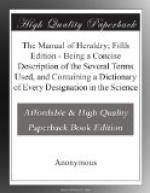Ex. Argent, a pile, azure, issuing from the chief between two others, transposed.
TREFOIL. Three-leaved grass: the shamrock of Ireland. When a flower or leaf is introduced as a charge in a shield of arms, if it is of its natural colour, or, in heraldic language, proper, the tincture is not named, but if of any other colour it must be described.
[Illustration: Trefoil]
Ex. Argent, three trefoils, gules, one over two.
[Illustration: Tressure]
TRESSURE. An ordinary not so broad as an orle. It generally forms a border to the inescutcheon. Tressures are frequently borne double, and sometimes treble. They are generally ornamented flory and counter-flory. The example contains only a single tressure. The arms of Scotland exhibit an example of a double tressure flory and counter-flory, as exhibited in the shield on the title-page of this Manual. See DOUBLE TRESSURE.
TRICORPORATED. Three lions rampant, conjoined, under one head, guardant, in the fess points. See LIONS.
TRIPPING. The motion of deer, between running and walking.
[Illustration: Tripping]
Ex. Argent, a stag proper, tripping.
[Illustration: Turband]
TURBAND. In coats of arms, where the knight was a Crusader, this figure often appears. It was the form of the sultan’s turban at that period.
[Illustration: Turreted]
TURRETED. A wall or castle having small turrets. In the annexed example the square tower has circular turrets at the angles, and is therefore said to be turreted.
TUSKED. Any animal having tusks of a different tincture from its body is said to be tusked.
[Illustration: Tusked]
Ex. Argent, a boar’s head, erased proper, tusked gules.
UNDY. A term used to express the word wavy by Gwillim and other ancient armorists.
[Illustration: Wavy]
Ex. Argent, a bend undy, gules.
[Illustration: Vair]
VAIR. A kind of fur formerly used for the lining the garments of knights. It is represented in engraving by the figures of small bells ranged in lines, as in the annexed example. Unless the colour of the fur is named, vair is always argent and azure. The bend, the cross and saltier, are sometimes formed of this fur.
VAMBRACED. Armour for the arms.
[Illustration: Vambraced]
Ex. Argent, three dexter arms, vambraced, couped.
VAMPLATE. A word used by ancient heralds for armour for the hand, instead of gauntlet.
VENUS. The name of the planet, used for the colour vert by ancient heralds, who emblazoned the arms of sovereigns by planets instead of metals and colours.
VERDOY. A bordure charged with eight leaves.
[Illustration: Verdoy]
Ex. Vert, a bordure argent, verdoy, of trefoils.
[Illustration: Vert]
VERT. Green. It is represented in engraving by diagonal lines drawn from the dexter to the sinister side of the shield.




